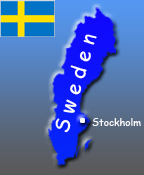Exhibition on Swedish favourite Carl Larsson
 Stockholm - Carl Larsson, whose work seems to represent a harmonious Sweden, is the subject of a new exhibition including many of his iconic images of his family at work and play.
Stockholm - Carl Larsson, whose work seems to represent a harmonious Sweden, is the subject of a new exhibition including many of his iconic images of his family at work and play.
In all some 100 works by Larsson (1853-1919) ranging from sketches to water colours and oils are on display at Prince Eugen's Waldemarsudde, an art museum on the Stockholm waterfront on the Djurgarden island.
Born to a poor family in Stockholm, Larsson's talent was spotted and he was accepted to the Royal Academy of Fine Arts. He then worked as an illustrator for newspapers, magazines and books.
He later moved to France where he struggled for several years before his 1882 move to Grez-sur-Loing outside Paris where he met Karin Bergoo, his wife-to-be, and mastered water colour.
Larsson made his breakthrough in 1883 when two of his water colours titled October and November were accepted at the Paris Salon.
In 1891 he was commissioned to decorate the entrance hall of the National Museum in Stockholm, of which one featuring the sacrifice of a mythical king generated controversy.
Larsson and his family later settled in Sundborn in the province of Dalarna, western Sweden. The home formed a backdrop for Larsson's work and became well-known when Larsson made a series of water colours for the 1897 World Expo in Stockholm.
They were later reprinted in the best-selling book A Home, which sold in several hundred thousand copies in Germany alone.
Eight of the 24 water colours from the series are on display offering a chance to see Larsson's skill with colours and with sketches.
Many Sundborn motifs have been reproduced in numerous prints and on items ranging from cookie tins to matchboxes and trays.
A rarely seen work on display was a water colour of Karin as a bride painted 1883 in Grez-sur-Loing. It is owned by a private collector, and has not been shown to the general public for some 50 years.
Torsten Gunnarsson, director of collections at the National Musem in Stockholm and main author of an accompanying catalogue, said the exhibition shows Larsson's versatility.
"He is a very distinctive artist even in an international comparison," Gunnarsson told Deutsche Presse-Agentur dpa.
"He has no real equivalent, at least in scope, who so consequently depicted this era, his own family and home, and consciously reproduces and spreads his works."
Larsson was also "extremely versatile" - ranging from book illustrations to huge frescoes, Gunnarsson said.
His style has touches of Jugend, but the artist-home also has links to the English Arts and Crafts movement, Gunnarsson said, noting that Larsson's artist-home is today perhaps regarded as part of an old Swedish tradition, "but was completely new at the time."
The eight children were for instance allowed to roam freely in all parts of the house at Sundborn.
When they were older Karin was able to pursue her own artistic career especially in textiles, Gunnarsson said, noting that Larsson also relied on his wife to pass judgement on his work.
The venue for the exhibition is Prince Eugen's Waldemarsudde, the artist-home of Prince Eugen (1865-1947), a friend of Larsson's.
The prince, a member of the royal family and accomplished landscape painter, bequeathed his home and art collection to the Swedish people.
The exhibition includes previously unpublished letters the two artists exchanged from 1891 to 1918, shortly before Larsson's death.
Some of the letters reflect other sides of Larsson, including his doubts about his career and differences over trends in art.
Museum head Elsebeth Welander-Berggren said the prince owned 14 works by Larsson, and several were part of the exhibition.
The exhibition runs through May 31. More details on the internet: www.waldemarsudde.se (dpa)